This guideline provides an overview of the sequence and content of a function focused/constraints led assessment of an infant of 8-12 months with developmental delay, including infants who are:
- late learning to sit independently;
- not yet creeping or crawling;
- late learning to stand with support or starting to cruise.
By this age infants should have developed a wide range of communication, hand and gross motor abilities. Gross motor development proceeds along a set of pathways: actions in supine, prone, sitting and standing, stepping and early walking. The Alberta Infant Movement Scales (AIMS) is a good option for a standardized assessment of development along each of these pathways.
In contrast to an observation based assessment of an infant's abilities, a function focused/constraints led assessment provides the therapist with a systematic way to assess what the infant can/cannot do and also insights into the factors that contribute to task performance including:
- the interactions between musculoskeletal factors;
- the infant's temperament and motivation to move;
- physical and social environment;
- any differences in brain development that may be present.
In other words, the aim of the initial assessment of gross motor abilities is to provide a picture of the infant's progress along each developmental pathway, which developmental tasks are not yet mastered and the factors that limit (constrain) her ability to perform these tasks.
Assessment sequence and components
1 Family interview and data gathering
The family interview will usually include birth, developmental and medical history, as well as the parents' report on the infant's abilities and their concerns about development. This information provides the therapist with the information needed for planning the assessment of motor function.
2 Getting-to-know-you: establishing a positive relationship with the infant
This is a crucial step in the assessment process - get it wrong and your assessment goals becomes difficult to achieve. Infants of this age start to be wary of strangers, especially if they have a cautious nature. Your ability to persuade the infant to engage in your assessment activities will depend on whether the infant finds you interesting and nonthreatening and is willing to participate in the games you introduce to encourage her to move.
3 What motivates this infant? Choosing activities that will motivate the infant to move
At this age infants are often motivated to move because they want to get hold of interesting objects or cause interesting events to happen. It is useful to have a selection of toys and objects at hand that can be used for games that encourage looking at, reaching for and moving towards objects in the environment. This is particularly important for infants whose motivation to move in low.
4 Assessment of gross motor abilities and tasks - a pathways approach
Usually it is best to start with the activities that the infant is able to perform successfully and to do the least favorite and challenging activities last. This is a good way to get an idea of the infant's strengths and willingness to move when the challenge is not overwhelming.
The developmental pathways include:
- Supine and transitions from supine
- Sitting
- Prone and crawling
- Standing and cruising
Infants who are sitting independently and moving about on the floor will often dislike being in prone - so leave these to the end of the session. An infant who is not yet sitting independently may be happy to lie supine, but refuse to stay in prone.
5 Assessment of flexibility
Assessing active flexibility is best done during the assessment of different gross motor tasks. Assessment of passive ROM which requires therapist hands-on actions, is often best left to the end of the session especially if the infant is very resistant to being handled.
Getting to know you - building a trusting relationship
With the infant sitting on the floor, usually close to the parent or on the parent's lap, the first step is to engage the infant socially and establish a relationship. This is particularly important if the infant is very cautious and reacts negatively to your presence.
I suggest you sit facing the infant at a distance that does not provoke a negative response. Activities and games that interest the 8-12 month old infant include: mirroring games, peek-a-boo, reaching for proffered toys, watching a play partner unpack a container of toys, rattles, banging games, catching and throwing balls.
Remember that during this getting-to-know-you phase of your assessment the activities should be interesting and easy for the infant to engage in and should not challenge the infant's balance, postural stability or movement abilities.
More information Let's Play: Mirroring is a powerful way to engage an infant Motivating a reluctant toddler
For subscribers Infant Hand Tasks 7-15 months
What motivates this infant?
The successful assessment of an infant's gross motor behavior and abilities depends on her willingness to engage in different activities. Infants who are active and enjoy exploring their environment will usually respond to any enticement to move - but many infants with developmental delay are not willing to try anything new or seems in any way difficult or challenging. Finding out what activities stimulates an infant's interest enough to overcome reluctance to move and willingness to pay attention is an important part of a successful assessment.
Overview of activities that motivate 8-12 month old infants to move
When the purpose of a game is to get the infant reaching and moving, it is important to choose activities that involve repeated reaching, grasping, and letting go rather than activities where the infant wants to explore the toy's possibilities. At this age infants become very involved in shaking toys that make a noise, and are unhappy when the toy is removed. On the other hand banging and drumming activities also involve a similar repeated actions, but has the advantage that the "drum" can be moved to encourage reaching in different directions.
Knocking over towers or other objects, posting activities and ball games are all good for encouraging repeated reaching actions.
My bag of gross motor assessment toys
Here is a list of the toys in my 8-12 month assessment bag. You will notice that most of these can be found in the kitchen or recycling bin.
A set of yogurt tubs, empty plastic bottles of different sizes, a couple of plastic jars, cloths of different sizes, a box or tin to use as a drum, a set of plastic beakers, several small balls.
Observation/assessment of gross motor developmental pathways
Observation in sitting
A this age most infants will have learned to sit,either independently or with some support, which makes sitting a good place to start your observation.
Overview of sitting developmental pathway for infants 8-12 months (See Development of Sitting for more details)
The infant is able to: sit independently, turn the head in all directions, reach for objects within easy reach and further than arm's reaching distance, to the same side and across the body, transition from sitting to prone kneeling
. 




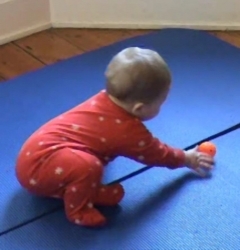
Step 1: What level of support is needed?
The first step is to find out what level of support the infant needs to maintain sitting: chest high support, support around the pelvis, sits without support but falls over easily, sits independently.
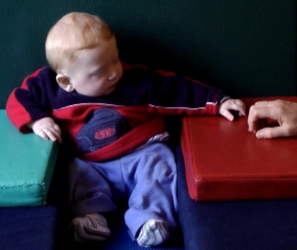
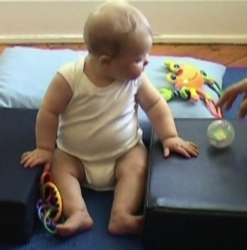

Step 2: Ability to maintain upright sitting when reaching
Once the infant is sitting with the appropriate amount and type of support needed to maintain sitting, the next step is to assess the infant's ability to keep the head and trunk steady and maintain balance when reaching, both within near body space (within arm's length) and beyond arm's length.

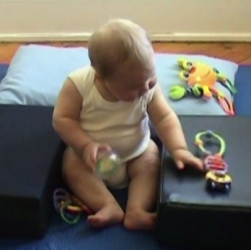



Step 3: Transition to prone kneeling
If the infant is able to sit independently, you also need to assess her ability to transition from sitting to prone kneeling.

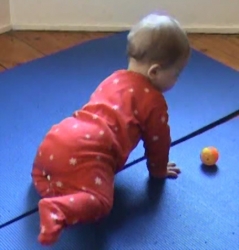
For Subscribers: Detailed Assessment of Sitting with checklist
Observation and assessment in standing
Standing developmental pathway
Between the ages of 8-12 months infants should have learned to take weight on the LEs with hand support on a suitable surface, will learn to maintain balance while reaching for toys in all directions, start to step sideways (cruise) and pull themselves up into standing and sit down again with good control. See Development of Standing with Support
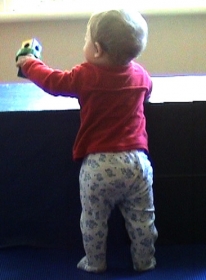



Step 1 Identify the type and amount of support the infant needs
Identify the level of support needed for the infant to stand on the feet, either with manual support around the chest or waist, or standing with hand support on a waist or chess high support surface.





Step 2: Assess ability to maintain balance and reach in different directions
Once you have identified the height of the support surface that allows the infant to support herself in standing using chest, elbow or hand support, the next step is to assess the infants ability to maintain balance and lift one hand to reach for toys in different directions.

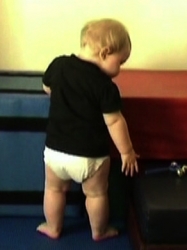

Also provide an opportunity for the infant to pull herself to standing and stand facing the parent holding onto parent's hands or clothing.

Step 3 Assessment of ability to stand up from floor from bench sitting to standing


For subscribers: Assessment of Standing
Observation and assessment in prone and prone kneeling
Between the ages of 8 and 12 months infants should learn to move around on the floor in prone (commando crawl) push up into prone kneeling, transition from prone to sitting, and support themselves kneeling at a step. See Development in Prone for details


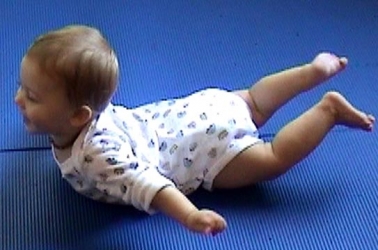
Some, but not all, infants will push up from prone to prone kneeling and start to crawl with a reciprocal gait.


Observation in Prone
Step 1 Observe posture and movement in prone on a flat surface
Once an infant is able to sit independently and can transition from prone to sitting she will usually not be willing to spend time in prone.
Position the infant in prone (the parent can do this if necessary). Place toys in the vicinity to encourage the infant to reach for the toys and to start moving on the floor.
Observe the infant's posture, ability to extend the spine, support self on arms, pivot and reach for toys.




Step 2: Adapt the support surface to encourage infant to tolerate prone.
If the infant is vey unhappy lying flat on a hard surface, they may tolerate lying with the chest on a small step and in this position will start to lift the head, extend the spine and use the UEs for support.

Observation or crawling and other modes of locomotion
Observe the pattern of movement used by the infant to crawl or shift on the buttocks.
Asymmetrical patterns of locomotion usually indicate restricted range of movement in the trunk-limb linkages.
. 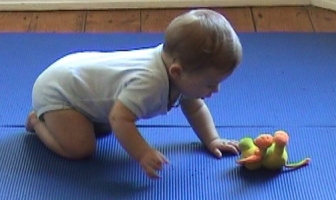
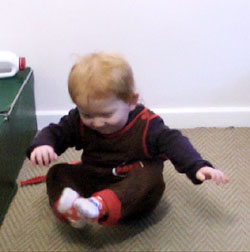
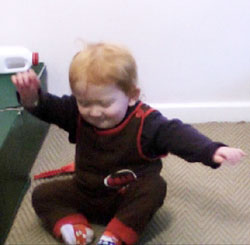
Assessment of flexibility
Infants who experience difficulties achieving the basic movement abilities usually have some degree of restricted movement in one or more of the trunk-limb fascial systems.
Assessing flexibility at this age can be difficult as the infant will often not tolerate handling by the therapist, especially at a first visit. In this case it is best to instruct the parent on how to perform the movements to be tested.
You assessment should include assessment of the following movements
► Neck flexion and rotation
► Trunk rotation in sitting - with forward reach of the arm
► Trunk elongation in sitting
► Trunk side flexion - lateral pelvic tilt in supine
► Shoulder elevation and adduction in sitting
► Pelvic rotation in supine
► Hip flexion with adduction in supine or bench sitting
► Hip rotation in flexion and extension
► Popliteal angle
► Dorsiflexion
What next? The Home Practice Program
In most situations it will take more than one therapy sessions to do a full functional assessment with analysis of constraints using adaptation of the task . However, for all the tasks you have assessed you will have a good idea of the intervention activities that can be integrated into the infant's daily routines and short dedicated home practice sessions.
Parents observing the process of task analysis and adaptation allows helps them to understand their child's motor difficulties and together the parent and therapist can devise practice opportunities that can be integrated into the daily routines.
There is also a place for incorporating several dedicated short practice sessions to focus on training of particular tasks that need repetition to promote strength, flexibility and motor learning.
For subscribers: Task Oriented Movement Therapy Online Manual
Return to TOM-T Assessment Guidelines